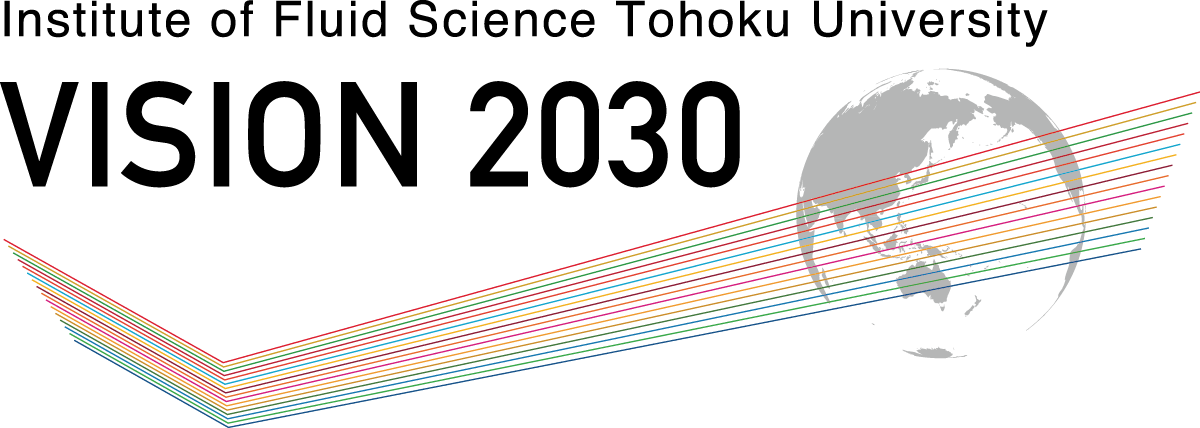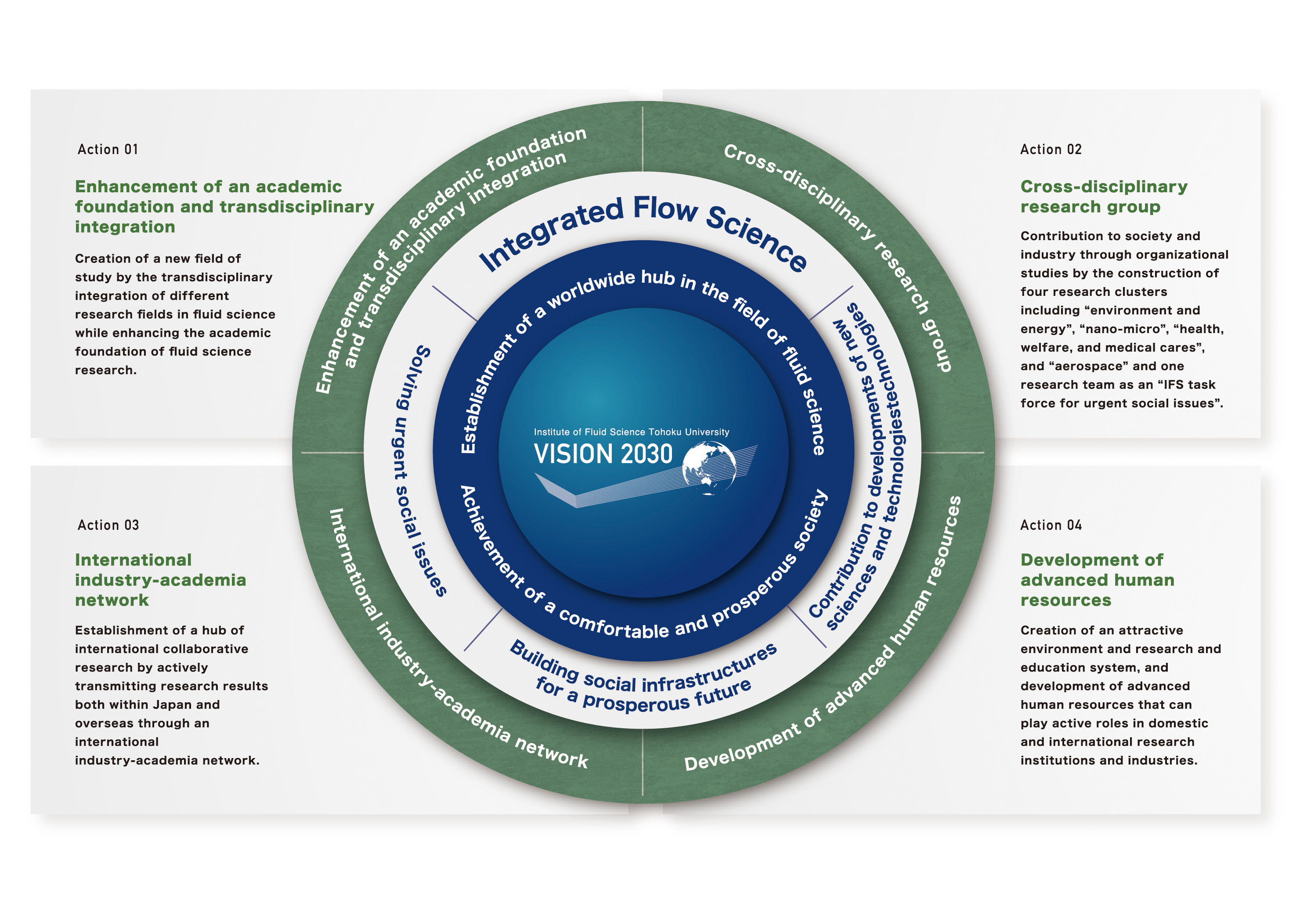Laboratory
Misson and Vision
Mission
- 1. Promote world-class research
- 1. Carry out basic research in Fluid Science
- 2. Promote interdisciplinary collaboration with other advanced fields using basic research results
- 3. Develop technological applications in priority science and technological areas
- 2. Establish new scientific theories and principles
- 3. Find solutions to issues facing mankind
- 4. Foster young researchers and engineers capable of working internationally
Vision

Establishment of a worldwide hub in the field of fluid science
Fluid science is the foundation of various physical phenomena and is indispensable for the sustainable development of human society and the solution of our country’s problems. The Institute of Fluid Science was established in 1943 as the Institute of High-Speed Mechanics and has led the world in fluid machinery research. The institute was reorganized in 1989 and has promoted theories and applications related to fluids while developing interdisciplinary research in a wide range of flow phenomena. It has played a role in the establishment of new scientific principles, solutions to various problems facing society, and the development of young researchers and engineers from around world as the one and only research institute for fluid science in Japan.
It is predicted that domestic problems such as population decline, labor shortage, and super-aging, as well as world problems such as population explosion, climate change, environmental pollution, shortages of water and food, and public health will pose significant challenges to the social environment by 2030. In response to these global trends, SDGs (Sustainable Development Goals) were adopted at the United Nations Summit in 2015 as social issues to be solved. To achieve an international society with carbon neutrality by 2050, 2030 is considered an important year as a milestone leading up to 2050 especially regarding climate change issues, and the “Green Growth Strategy Through Achieving Carbon Neutrality in 2050” was formulated in Japan in 2020. In addition, the global COVID-19 pandemic of 2020 revealed the importance and the issues of public health. It is hoped that new scientific technologies that will promote Society 5.0 proposed by the Cabinet Office will help to mitigate these problems and enable continual development of a prosperous society. It is strongly desired that the research institutes of national universities in Japan flexibly respond to social changes with comprehensive, multidisciplinary and international efforts to solve these problems. Therefore, expertise from around the world should be brought together towards new objectives, and an environment where researchers can inspire one another to undertake innovative research should be fostered.
We established the VISION 2030 to achieve the formation of a worldwide hub in fluid science by 2030 in which researchers from all over the world can work together, taking advantages of accumulated research, technologies, and international networking to solve the social challenges. Then, we will aim to achieve the establishment of a safe, secure, healthy, comfortable, and prosperous society by the continued progress of the academic fundamentals of fluid science and the measurement and analysis technologies of thermo-fluid dynamics. To achieve these goals, we construct an integrated flow science, and aim to come up with innovative solutions related to the environment and energy, nano-micro, health, welfare and medical cares, and aerospace. Specifically, we contribute to the development of a social foundation for carbon neutrality, disaster prevention and mitigation, health and preventive health care, and space utilization by working on the developments of fundamental technologies according to the Green Growth Strategy through the utilization of ammonia fuel, geothermal energy, hydrogen energy, semiconductor processes with earth-friendly, and large-capacity batteries, electrification of aircrafts, and new sciences and technologies related to biotechnologies for medical care and drug development, and AI, machine learning, and quantum computer which accelerate digital transformation. At the same time, we also contribute to solving urgent social issues at that time.
Toward the realization of these goals, the following tasks are necessary. 1. Creation of a new field of study by the transdisciplinary integration of different research fields while enhancing the academic foundation of fluid science research. 2. Contribution to society and industry through organizational studies by the construction of four research clusters including “environment and energy”, “nano-micro”, “health, welfare, and medical cares”, and “aerospace” and one research team as an “IFS task force for urgent social issues”. 3. Creation of an attractive research and education system and environment, and development of advanced human resources that can play active roles in domestic and international research institutions and industries. 4. Establishment of a hub of international collaborative research by actively transmitting research results both within Japan and overseas through an international industry-academia network.

Background for the revision of the VISION 2030
The Institute of Fluid Science established “VISION 2030” in April 2015. After the establishment of the VISION 2030, the direction for the development of global and Japanese societies and the request of expected science and technology, such as the SDGs (adopted at the United Nations Summit in September 2015), Society 5.0 (proposed in the 5th Science and Technology Basic Plan in 2016), and Green Growth Strategy Through Achieving Carbon Neutrality in 2050 (formulated in December 2020) were newly proposed. In addition, it is also necessary to establish a research system to solve urgent social issues due to the global COVID-19 pandemic. Based on these circumstances, we decided to revise the VISION 2030.
History
Institute of High-Speed Mechanics
- Oct. 5, 1943
- Inauguration as the Institute of High-Speed Mechanics at Tohoku Imperial University
- Mar. 25, 1969
- Completion of Building No.1
- Apr. 1, 1979
- Opening of Air-Flow Measurements Facility, establishment of Low-Turbulance Wind Tunnel
- Apr. 1, 1988
- Retiring of Air-Flow Measurements Facility, opening of Shock Wave Research Center
Institute of Fluid Science
- May. 29, 1989
- Organizational change to the Institute of Fluid Science, which consists of twelve research divisions and one attached research center
- Nov. 13, 1990
- Completion of Supercomputer Center
- Nov. 10, 1994
- Completion of Building No.2
- Apr. 9, 1998
- Organizational change of the Institute of Fluid Science into four divisions with sixteen laboratories under and one research center, i.e. Shock Wave Research Center
- Sept. 3, 1999
- Opening of Advanced Fluid information Research Center for efficient utilization supercomputer
- Apr. 1, 2000
- Establishment of Center Of Excellence (COE) formation program: “The Interdisciplinary Shock Wave Research Center”
- Oct. 2001
- Establishment of International Exchange Division
- Apr. 1, 2003
- Shock Wave Research Center reorganization leads to inauguration of Transdisciplinary Fluid Integration Research Center
- Sept. 1, 2003
- Establishment of 21st century COE program: “International COE of Flow Dynamics”
- Jul. 1, 2008
- Establishment of Global COE program: “World Center of Education and Research for Trans-Disciplinary Flow Dynamics”
- Apr. 1, 2010
- Commencement of Joint Usage/Research Center “Fluid Science Research Center”
- Apr. 1, 2013
- Organizational change of the Institute of Fluid Science into three research divisions and one attached research center with twenty-seven laboratories
- Apr. 1, 2013
- Establishment of “Advanced Flow Experiment Research Center”
- Apr. 1, 2015
- Opening of Fundamental Research of Advanced Vehicle Technology (KEIHIN)
- May 13, 2015
- Organizational change of the International Exchange Division into Global Collaborative Research and Education Center
- Apr. 1, 2017
- Opening of Aircraft Computational Science Center for promoting aviation industry in Japan
- Apr. 1, 2018
- Opening of attached Lyon Center (LyC) for promoting international joint research with Université de Lyon
- Jul. 1, 2021
- Start of Fundamental Research of Advanced Vehicle Technology (Hitachi Astemo) III
- Sept. 1, 2022
- Establishment of IHI × Tohoku University Co-creation Research Center of Ammonia Value Chain for Carbon Neutrality
- Oct. 1, 2022
- Integration of Innovative Energy Research Center, Lyon Center, and Global Collaborative Research and Education Center leads to Global Collaborative Research and Education Center for Integrated Flow Science (IFS-GCORE).

